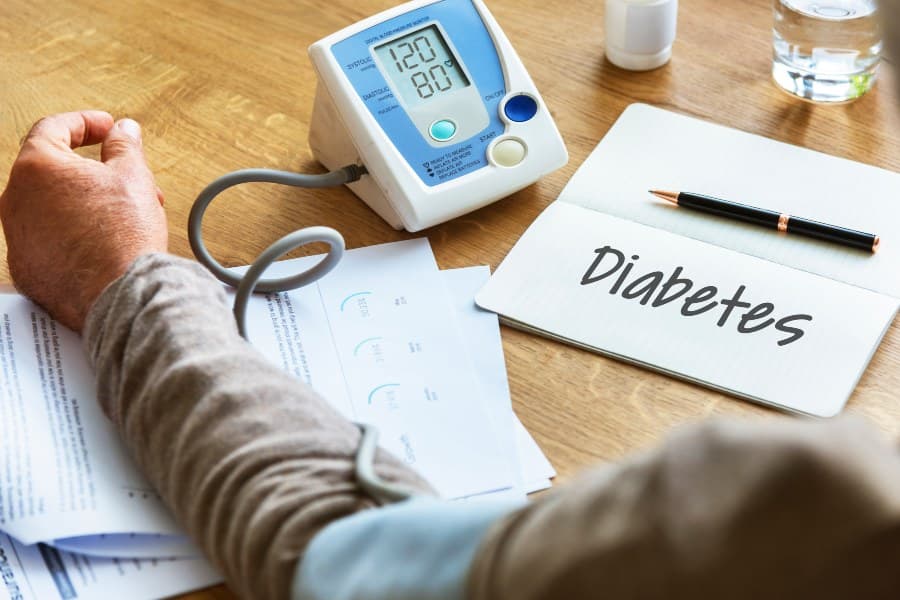English
Deutsch
Русский
عربي

Preventive Measures for Diabetes: Lifestyle Changes for Risk Reduction
MedicusUnion Team
March 20, 2024
4 min. read
Diabetes, a chronic metabolic disorder characterized by elevated blood sugar levels, has become a global health concern. The prevalence of diabetes is on the rise, with millions of people affected worldwide. While genetics can play a role in diabetes, lifestyle factors are significant contributors to its development.
Prediabetes is the period before diabetes is diagnosed where blood sugar levels are high but not high enough to be diagnosed as diabetes. It’s estimated that up to 37% of people with untreated prediabetes develop type 2 diabetes within 4 years.
Fortunately, you can significantly reduce the risks of developing it by taking preventive measures through lifestyle changes. In this article, we will explore some key changes in your lifestyle that can help you minimize the risks and promote overall well-being.
Type 1 Diabetes
Type 1 diabetes (once known as juvenile diabetes or insulin-dependent diabetes) is a chronic condition, in which the pancreas produces little or no insulin at all and requires daily administration of insulin. Insulin is a hormone the body uses to allow sugar (glucose) to enter cells to produce energy. The insulin-producing cells are being attacked and destroyed by the immune system. This is why type 1 diabetes is also known as an autoimmune condition.
There is currently no cure for type 1 diabetes but research continues.
Type 2 Diabetes
Type 2 diabetes (formerly called non-insulin dependent, or adult onset) isn’t an autoimmune condition. It most often develops in people over age 45, but more and more children, teens, and young adults are also developing it.
In type 2 diabetes, cells do not respond normally to insulin, which is called insulin resistance. The pancreas tries to get cells to respond by producing more insulin. Eventually it can’t keep up and blood sugar rises, setting the stage for prediabetes and type 2 diabetes. High blood sugar is damaging to the body and can cause other serious health problems such as heart disease, vision loss and kidney disease.
Type 2 diabetes cannot be cured but there is evidence to say in many cases it can be prevented and put into remission.
Ways to Prevent Diabetes
Healthy Eating Habits
A balanced and nutritious diet is fundamental in preventing diabetes. Emphasize whole foods such as fruits, vegetables, whole grains, and lean proteins while limiting the intake of processed foods, sugary beverages, and refined carbohydrates. Incorporating fiber-rich foods into your diet helps regulate blood sugar levels and promotes a feeling of fullness, reducing the likelihood of overeating.
Try to Lose Excess Weight
Maintaining a healthy weight is closely linked to diabetes prevention. Excess body weight, particularly around the abdomen, is associated with insulin resistance, inflammation, prediabetes and is a significant risk factor for type 2 diabetes. is associated with insulin resistance, inflammation, prediabetes, and type 2 diabetes.
By adopting a balanced diet and incorporating regular exercise, you can achieve and sustain a healthy weight, reducing the risk of developing diabetes.
Quit Smoking
Smoking, especially heavy smoking, is strongly linked to diabetes risk and increases your chance of developing type 2 diabetes by 30-40%. Insulin helps sugar enter cells, but nicotine alters the cells' response to insulin, causing blood sugar levels to rise. The chemicals in cigarettes cause cell damage and inflammation, which further impairs the response to insulin.
Smokers also have an increased risk of fat buildup in the abdomen, which leads to an increased chance of developing type 2 diabetes, regardless of their overall weight.
Exercise Regularly
Being more active may help prevent diabetes. Exercise is one of the simplest and most effective ways to bring down blood-glucose levels, cut the risk of cardiovascular disease and improve overall health and well-being.
Try to spend at least 150 minutes a week doing moderate-intensity aerobic activity, such as brisk walking, and muscle-strengthening activities two or more days a week. Finding activities that you enjoy increases the likelihood that you will stick to an exercise routine.
Conclusion
Preventing diabetes involves making informed lifestyle choices that prioritize health and well-being. It's essential to approach these lifestyle changes as long-term commitments, as their cumulative impact plays a crucial role in diabetes prevention. Type 2 diabetes symptoms often develop over several years and can go on for a long time without being noticed (sometimes there aren’t any noticeable symptoms at all). Because symptoms can be hard to spot, it’s important to know the risk factors and to see your doctor to get your blood sugar tested if you have any of them.
If you do realize that you are at risk or notice unusual symptoms, feel free to contact the doctors at MedicusUnion. We have gathered the best medical experts on our innovative platform and all of them would be happy to provide you with a consultation.

Get the MedicusUnion App!
- Certified Doctors
- Video consultation with a doctor
- Simultaneous interpreter during consultations